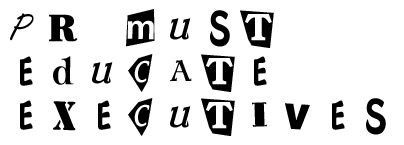Max is an account supervisor at a PR agency in New York City
Key Takeaways from the Q&A:
1) Working in social media is a 24/7 job that requires an estimated 50-60 hours of work per week.
2) PR practitioners should leverage Diagnostic, Quantcast, Radian6 and Sysomos MAP for PR measurement.
3) Social media does drive bottom line business sales.
4) It is a PR agency’s role to educate executives on the effectiveness of social media.
5) Leveraging social media has enabled PR agencies to gain a competitive advantage over other agencies.
1) Working in social media is a 24/7 job that requires an estimated 50-60 hours of work per week.
2) PR practitioners should leverage Diagnostic, Quantcast, Radian6 and Sysomos MAP for PR measurement.
3) Social media does drive bottom line business sales.
4) It is a PR agency’s role to educate executives on the effectiveness of social media.
5) Leveraging social media has enabled PR agencies to gain a competitive advantage over other agencies.
What is your favorite part about working in social media? My favorite part about working in social media is the ability to engage with consumers and businesses on a real time basis on behalf of a brand that they care passionately about. The medium allows for such great versatility in ways of speaking to fans that there’s never a dull moment.
Given that social media is on 24/7, what can you expect your workweek to look like at a PR agency? Fortunately, PR Agency is a global team that uses its resources accordingly. We have global teams that allow us to always be on for our clients. That said, we do work in the advertising and PR industry, which requires some commitment to checking your mobile device for any urgent matters. A normal workweek for us is probably somewhere in the realm of 50-60 hours.
What social media measurement tools, applications or websites do you use at a PR agency to measure a campaign's ROI? Which tools do you find the most effective? There are a number of measurement tools we use to measure the effectiveness of our programs. Every plan, program, and campaign has different metrics, and therefore, different tools to measure. At a PR agency, we try to stick to our measurement model that tracks Diagnostic metrics and KPIs on three verticals (Reach, Action and Preference). Within those verticals, we measure different things depending on the platforms that are being used as well as the client’s overall goals. We also use several different tools to measure other elements such as influence (i.e. using Quantcast to measure Unique Monthly Visits to influencer websites, or using Radian6 and Sysomos MAP to monitor activity and reach of a hashtag). The list is truly endless in terms of tools you can use. The key is figuring out the right KPIs and Diagnostic metrics that move those KPIs for each particular program/campaign that will create value added for the client.
What do you think is the most noteworthy social media success and disaster? Please elaborate on each example. I think a great example of a social media success in a small scale would be the current Oreo’s campaign for the 100th anniversary. It took three agencies to work together to achieve something that puts the product in consumer’s minds in a way that is shareable and timely. They truly understood the idea behind having something that is remarkable that people will want to share, and it most definitely created a lot of buzz around the brand. There are several examples of social media disasters; we see them every day and on a regular basis. The issue is that brands need to try new things and in that process, sometimes things go wrong. There is also the trend known as “flawsome” where a company who commits a social media flaw acknowledges it and then uses it to its advantage. If I had to give an example where this might not have been the case and a company (or their agency) failed drastically in the social space, I would probably say that Ragu did it pretty bad. They decided to have a campaign of moms talking about how Dads were terrible at cooking and then they spread the videos to Dad bloggers, as if dads would be interested. The idea behind using influencers was right and they probably meant for it to come off as comedic. However, they failed to recognize their audience and instead alienated a large segment of the population; and as we know, these things tend to spread fast in the social space.
How important do you think a brand's social media presence is to ensuring its success? Why do you think this is? It all depends on what your definition of success is. If success means affecting the bottom line, then that line is still trying to be determined. However, several studies do show how people who are willing to publicly state that they “like” a brand tend to become advocates for it if the relationship is nurtured. It is not necessary for a brand to be in every social media platform that is out there. What is important is that the brand does well in the platforms that it chooses to participate in. Each of these platforms has its purpose and its audience, and when a brand gets it right, it will reap tremendous benefits. This could be in terms of brand awareness, brand recognition, brand advocacy or even brand preference. That said, you’ll start seeing a lot more brands using social to drive sales, which will ultimately lead to a strong correlation between the brand’s social media presence and the bottom line.
When working with clients, how great of an importance do they put on social media as it relates to top-line business objectives? Please elaborate. It is still a work in progress and although companies are putting more efforts (and budgets) into the social space, most companies are still slow to put enough resources to make a difference in top-line business objectives. It is the agency’s role to educate the executives and come up with campaigns that can be measured against those top-line objectives to prove their value and therefore increase the budget that is allocated. Most companies continue to measure Social Media in advertising terms instead of understand that Social Media is in a category onto itself that involves the PR and Advertising space.
What actions does a PR agency's take to better educate their employees about social media trends, usage and measurement? We offer several training programs for executives in social media. Moreover, we do the same internally, taking all our employees through different levels of social media training so that they are educated when talking to clients. We also provide clients with regular updates on new social media developments as well as include our extensive thought leadership in the space on our webpage and blog, continuously updating it and distributing it to clients.
What do employees at a PR agency do to ensure a brand's social media messaging is consistent across all social platforms. We develop extensive social brand voice guidelines that we use for a brand in all social platforms. Although different platforms have different requirements and tones, we use strict social voice guidelines so that fans and followers are able to recognize and relate to a brand consistently throughout their social media interactions.
What external communication platforms does a PR agency use to promote its corporate brand? Do you think these platforms are successful in promoting a positive public image? We use several platforms to promote our corporate brand including Facebook, Twitter, Blog, and Slideshare to name a few. I think these platforms are definitely making a positive impact in the public image of the company. We recently conducted a study of our brand vs. competitors to measure how we were doing within our competitive set and we were very pleased with the results, especially given the new improvements we’ve done to our external communication platforms.
What internal communication platforms does a PR agency use? Are employees active on the platforms? We have our own internal platforms that we use to communicate as well as to share knowledge. Some offices and accounts use Yammer and at a PR agency we also have our internal Wiki. Moreover, we also have a private Facebook group where we all contribute interesting facts and campaigns so that we are all kept up to date. Communication is key in our business and the more armed you are with it, the better you can be for your clients.











 RSS Feed
RSS Feed